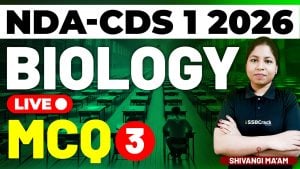The Mathematics section of the Combined Defence Services (CDS) Exam demands a clear understanding of fundamental concepts combined with the ability to solve problems efficiently. A recent class was conducted to strengthen aspirants’ knowledge of Statistics and Progressions, focusing on key subtopics essential for the exam. This session provided a comprehensive discussion on the relationship between mean, median, and mode, data representation techniques, cumulative frequency curves, and arithmetic and geometric progressions.
This blog provides insights into the class, preparation strategies for these topics, and tips for success in the CDS Exam.
Highlights of the Class
1. Relation Between Mean, Median, and Mode
The class began with an explanation of how mean, median, and mode relate to each other in a data set. Understanding this relationship helps in identifying data distribution trends and solving related problems quickly. The instructor provided clear examples to show how these measures are connected and when to apply each measure based on the nature of the dataset.
2. Data Representation Techniques
Visualization of data is an essential skill for answering questions in the Statistics section. The following methods were discussed in detail:
- Bar Graphs: Used for comparing discrete categories. Students learned how to interpret bar heights and compare different data sets effectively.
- Histograms: These were introduced as a tool for representing continuous data and frequency distributions. Tips on creating and interpreting histograms were shared.
- Pie Charts: The class emphasized how to read and compare proportions visually using pie charts. Practical examples helped students grasp their application.
- Frequency Polygons: This graphical representation of frequency data was explained as an alternative to histograms, particularly for identifying trends over intervals.
3. Cumulative Frequency Curves (Ogives)
Cumulative frequency curves, also known as ogives, were covered in-depth. Students learned about the two types:
- Less Than Ogive: Represents cumulative frequencies for values less than or equal to a certain point.
- More Than Ogive: Represents cumulative frequencies for values greater than a certain point.
The class highlighted how ogives are used to estimate medians and percentiles, a skill crucial for solving exam questions.
4. Progressions: AP and GP
The second part of the session delved into progressions:
- Arithmetic Progression (AP): Defined by a constant difference between consecutive terms, AP forms the basis for many problem-solving scenarios in the CDS Exam.
- Geometric Progression (GP): Here, each term is multiplied by a constant factor to obtain the next term. The instructor demonstrated its practical applications, such as growth models.
5. Means: Arithmetic, Geometric, and Harmonic
The class concluded with a discussion on the three types of means:
- Arithmetic Mean (AM): The average of numbers, useful for understanding central tendencies in evenly distributed data.
- Geometric Mean (GM): Often used in growth rates or when data is multiplicative in nature.
- Harmonic Mean (HM): Explained as particularly useful in problems involving rates or speeds.
Examples were provided to illustrate when and why each mean is applicable, enabling students to choose the right approach for exam questions.
Strategies to Prepare for Statistics and Progressions in the CDS Exam
1. Build a Strong Foundation
- Understand the definitions and applications of key terms such as mean, median, mode, AP, and GP.
- Familiarize yourself with the graphical representation of data.
2. Practice Data Interpretation
- Solve problems involving bar graphs, histograms, and pie charts to become comfortable interpreting different data visualizations.
- Practice constructing frequency polygons and cumulative frequency curves to solidify your understanding.
3. Master the Basics of Progressions
- Memorize the general terms and properties of AP and GP.
- Practice questions involving finding missing terms, sums, and common differences or ratios.
4. Focus on Applied Understanding
- Learn the conditions for applying less than and more than ogives, and understand how to extract insights from cumulative frequency curves.
- Practice using different types of means in real-world scenarios, such as finding average speeds or rates.
5. Prioritize Problem-Solving
- Solve previous years’ CDS questions related to Statistics and Progressions to understand the exam pattern.
- Attempt mock tests to improve speed and accuracy while working under time constraints.
6. Use Visual Aids
- Draw diagrams, graphs, and curves to visualize problems and reinforce your understanding.
- Use color-coded notes or flashcards for quick revision of formulas and key points.
7. Revise Regularly
- Dedicate time for revisiting fundamental concepts and reviewing mistakes from practice sessions.
- Ensure you revise graphical interpretations, as these are common in CDS questions.
8. Seek Guidance
- Discuss doubts with peers or instructors to clarify concepts.
- Utilize study materials and online resources tailored for CDS exam preparation.
Common Mistakes to Avoid
- Neglecting Conceptual Clarity: Memorizing formulas without understanding their applications can lead to confusion during the exam.
- Rushing Through Graphical Questions: Skimming graphs or charts without analyzing them properly often results in errors.
- Misinterpreting Data: Ensure accuracy while reading cumulative frequencies, ogives, or data distributions.
- Ignoring Progression Formulas: Missing a key formula in AP or GP questions can cost valuable marks.
- Not Reviewing Mistakes: Failing to learn from errors in practice sessions can hinder improvement.
Conclusion
The recent class on Statistics and Progressions was a valuable session for aspirants preparing for the CDS Exam. It provided comprehensive coverage of key subtopics, from understanding relationships between statistical measures to interpreting data and mastering progressions.
For effective preparation, focus on conceptual clarity, regular practice, and time management. By combining these strategies with consistent revision, you can approach the Statistics and Progressions sections with confidence. With dedication and a clear understanding of these topics, you can enhance your chances of success in the CDS Exam.
Stay consistent, practice diligently, and aim high!



















